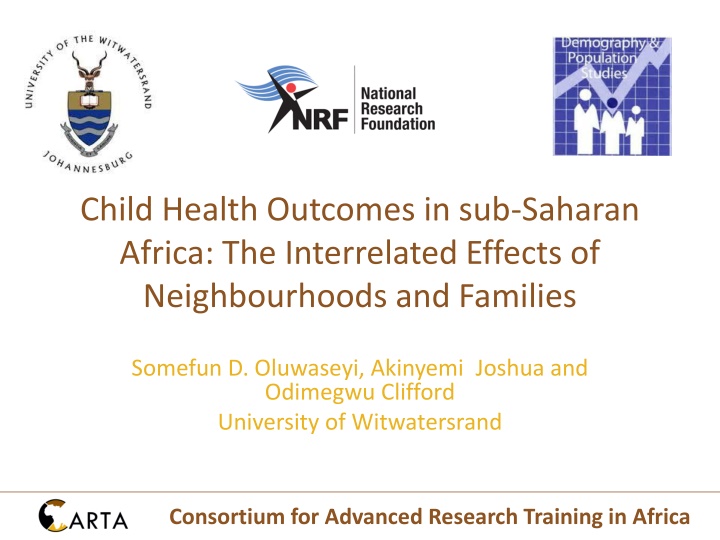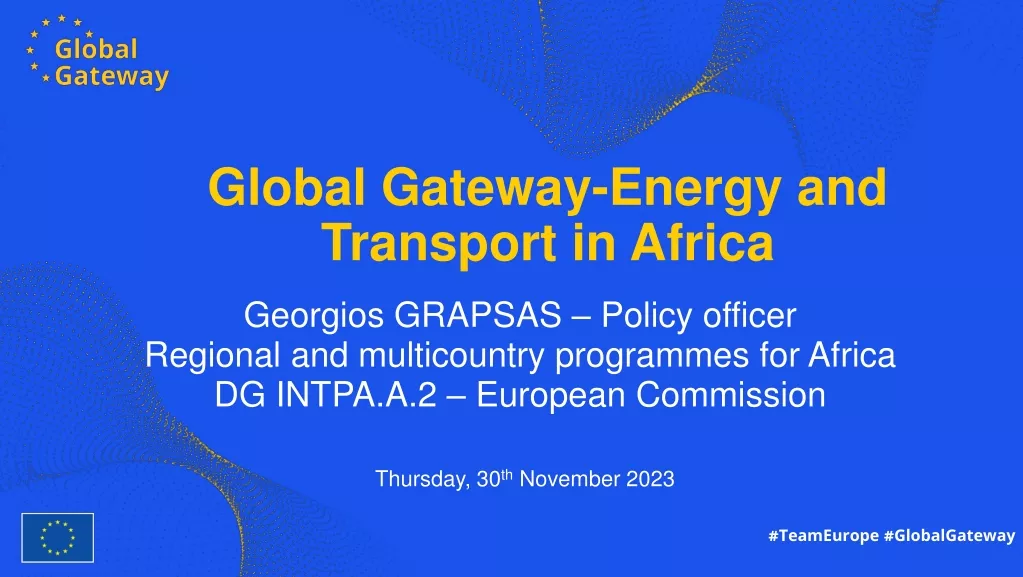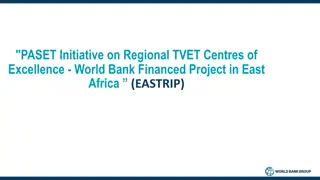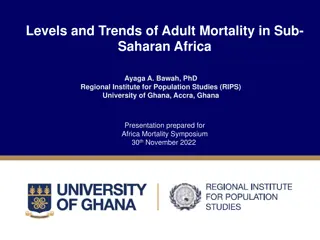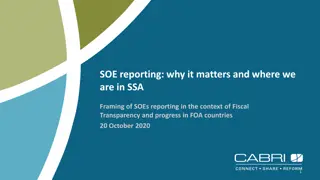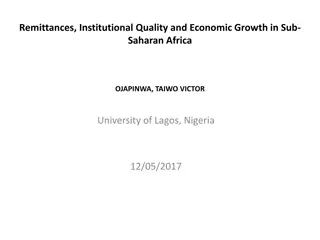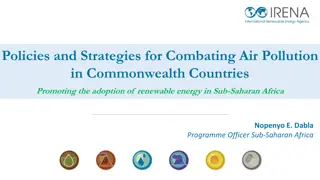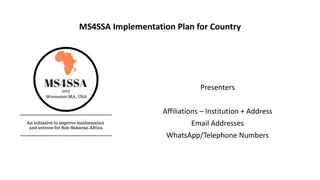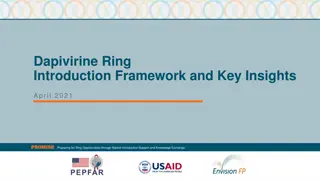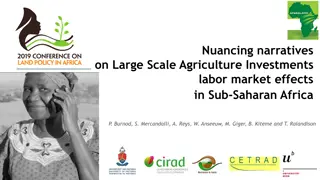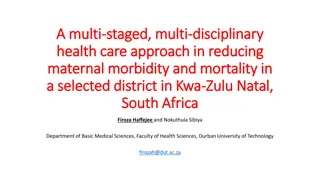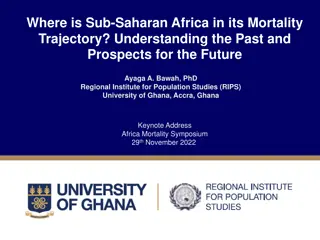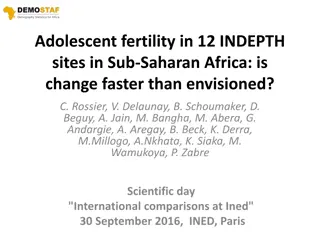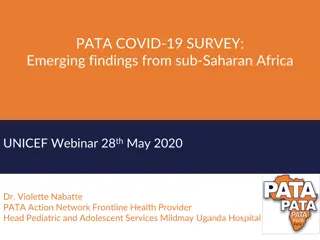Impact of Family Structure on Child Health Outcomes in Sub-Saharan Africa
This study explores the interplay between family dynamics and child health outcomes in Sub-Saharan Africa, focusing on the effects of neighbourhoods and families on stunting rates. It delves into the challenges posed by stunting, the role of socio-demographic factors, and the changing landscape of female household headship in the region.
Download Presentation

Please find below an Image/Link to download the presentation.
The content on the website is provided AS IS for your information and personal use only. It may not be sold, licensed, or shared on other websites without obtaining consent from the author.If you encounter any issues during the download, it is possible that the publisher has removed the file from their server.
You are allowed to download the files provided on this website for personal or commercial use, subject to the condition that they are used lawfully. All files are the property of their respective owners.
The content on the website is provided AS IS for your information and personal use only. It may not be sold, licensed, or shared on other websites without obtaining consent from the author.
E N D
Presentation Transcript
Child Health Outcomes in sub-Saharan Africa: The Interrelated Effects of Neighbourhoods and Families Somefun D. Oluwaseyi, Akinyemi Joshua and Odimegwu Clifford University of Witwatersrand Consortium for Advanced Research Training in Africa
Background Due to Poverty Reduction Strategy papers (PRSPs) and the heavily Indebted Poor Countries (HIPC) initiative, the support of public sector has increased in SSA reaching 36.6 USD in 2011 vs 8.2 USD billion in 2000 (Grekou, 2014). But, more than 6 million children still die before their 5th birthday (UNDP, 2015). The broad vision of sustainable development goal 3 will not be achieved unless more substantial progress on the proposed target to end preventable deaths of new-borns and children under 5 is made. Consortium for Advanced Research Training in Africa 2/26/2025 2
Background Stunting constitute a major public health challenge with highest prevalence of 39% in developing countries (WHO, 2010). Rates are highest in South-central Asia and sub-Saharan Africa. Majority of countries in SSA have shown no improvement in stunting since 1990 and have high levels of young children moderately or severely stunted (more than 40%). For instance, Niger, Zambia, Malawi and Rwanda suffer from high levels of stunting (2010). Consortium for Advanced Research Training in Africa 2/26/2025 3
Background Different socio-demographic factors have been found to be associated with child stunting. Family related variables have also been identified as predictors of nutritional outcomes. Relationship was established between single motherhood and wasting in Brazil (Ayllon & Batista, 2015) In India, children in non-nuclear families had better nutritional status than counterparts in nuclear families (Kumar and Ram, 2013. Orphanhood was a risk factor for poor nutritional status in 11 selected SSA countries (Coneus et al, 2014). Consortium for Advanced Research Training in Africa 2/26/2025 4
Motivation Family dynamics are changing in SSA and it is important to understand how it affects child health outcomes Female household headship (FHH) has been documented to be on an increasing trend due to development, urbanization and other factors FHH is found all over SSA but ranges from country to country. In Namibia, almost 40% of households are headed by women and more than a third in Rwanda and Kenya. Our paper builds on the existing body of research that has found associations between family structure and child health outcomes to examine whether previous findings hold true for SSA. Consortium for Advanced Research Training in Africa 2/26/2025 5
Theoretical Outline Feminization of Poverty Theory Female headed households tend to be poorer than male headed households. FHH are the most vulnerable as they are generally in a state of continuous deprivation in terms of access to land, income and labour (Mason et al, 2014). FHH may also experience stigmatization and exclusion in communities resulting to limited access to facilities (Winskell et al, 2014). Consortium for Advanced Research Training in Africa 2/26/2025 6
Hypothesis There is no difference in the child health outcomes of children living in male headed households and children living in female headed households. Any difference in child health outcomes by family structure may be as a result of socio-economic status of household and community. Consortium for Advanced Research Training in Africa 2/26/2025 7
Design and Methodology Data Source: Demographic and Health Surveys (DHS). Study Population: Burundi (2010), Cameroon (2011), Congo DRC (2013-14), Malawi (2010), Mali (2012-13), Niger (2012), Nigeria (2013), Rwanda (2014), Zambia (2014), Zimbabwe (2010 -11) Outcome Variable: Stunting Consortium for Advanced Research Training in Africa 2/26/2025 8
Design and Methodology Main Independent Variable - Family structure; Sex of household head (Male vs Female) Other control variables include; child sex, number of children, place of residence, education, husband s education, wealth status, work status, marital dissolution, polygamy, received Antenatal Care, birth size and place of delivery. We also controlled for neighborhood factors such as: percentage of poor women, percentage of educated women, percentage of single women and percentage of women who got assistance during delivery Analysis: Logistic Regression Consortium for Advanced Research Training in Africa 2/26/2025 9
Analysis Descriptive statistics was used to summarize outcome and independent variables. Model 1 Independent effect of family structure and stunting Model 2 Model 1 and other control variables Model 3 Independent effect of family structure, community variables and stunting Model 4 Model 3 and other control variables Consortium for Advanced Research Training in Africa 2/26/2025 10
Percentage Distribution of FHH Female Headed Households 41.08 20.54 19.38 18.62 17.93 16.15 14.04 11.05 9.03 6.01 Burundi Cameroon Congo DRC Malawi Mali Niger Nigeria Rwanda Zambia Zimbabwe Country Consortium for Advanced Research Training in Africa 2/26/2025 11
Percentage Distribution of Stunting by Family Structure 50 45 40 35 30 25 20 15 10 5 0 Nigeria 37.23 26.87 Rwanda 36.54 40.94 Cameroon 32.01 29.05 Niger 41.64 43.92 MHH FHH MHH FHH Consortium for Advanced Research Training in Africa 2/26/2025 12
Adjusted Odds Ratio for Family Structure and Child Stunting Burundi Cameroon Congo DRC Malawi Mali Family Structure MHH FHH 0.99 (0.82-1.20) 0.86 (0.73-1.02) 0.99 (0.88-1.10) 1.05 (0.84 1.31) 0.98 (0.78 1.24) Niger Nigeria Rwanda Zambia Zimbabwe Family Structure MHH FHH 1.00 (0.87 1.14) 1.09 (0.91 1.30) 0.61 (0.56-0.68)*** 1.20 (1.00 1.43) 1.03 (0.93 1.14) Consortium for Advanced Research Training in Africa 2/26/2025 13
Adjusted Odds Ratio for Family Structure, Community Characteristics and Child Stunting Burundi Cameroon Congo DRC Malawi Mali Family Structure MHH FHH Comm Poverty Low Medium High Comm Edu Low Medium High Comm Single Low Medium High Comm Assisted Delivery Low Medium High 0.99 (0.81-1.21) 1.10 (0.91-1.32) 1.02 (0.91-1.15) 1.06 (0.84 1.33) 0.99 (0.76 1.28) 1.63 (1.30-2.06) 1.59 (1.25-2.02) 1.52 (1.23-1.88) 2.21 (1.73-2.83) 1.26 (1.06 1.49) *** 1.09 (0.90 1.31) 1.23 (1.04 1.46) * 1.17 (0.97 1.41) 1.52 (1.15 2.01) *** 1.70 (1.26 2.30) *** 0.81 (0.57-1.14) 0.68 (0.55-0.84) 0.89 (0.71-1.12) 0.57 (0.43-0.77) 0.92 (0.80 1.07) 0.56 (0.47 0.66) *** 0.89 (0.75 1.05 0.82 (0.68 0.98) 1.14 (0.89 1.47) 0.69 (0.52 0.91) * 0.86 (0.70-1.07) 1.06 (0.86-1.30) 0.83 (0.68-1.03) 0.85 (0.67-1.08) 0.90 (0.78 1.04) 0.81 (0.70 0.94) 1.13 (0.96 1.33) 1.20 (1.02 1.41) * 1.06 (0.62 1.79) 0.95 (0.77 1.18) 0.99 (0.77-1.28) 0.72 (0.58-0.88) 1.05 (0.85-1.30) 0.85 (0.67-1.07) 0.99 (0.84-1.16) 0.87 (0.74-1.02) 0.92 (0.78 1.07) 0.82 (0.69 0.96) * 0.78 (0.54 1.12) 0.73 (0.59 0.91) Consortium for Advanced Research Training in Africa 2/26/2025 14
Adjusted Odds Ratio for Family Structure, Community Characteristics and Child Stunting Niger Nigeria Rwanda Zambia Zimbabwe Family Structure MHH FHH Comm Poverty Low Medium High Comm Edu Low Medium High Comm Single Low Medium High Comm Assisted Delivery Low Medium High 1.08 (0.88 1.32) 1.24 (1.03 1.50) * 1.06 (0.96 1.18) 0.99 (0.86 1.13) 1.00 (0.90-1.11) 1.10 (0.88 1.39) 1.04 (0.82 1.31) 1.39 (1.22-1.60)*** 1.52 (1.25-1.84)*** 1.22 (0.98 1.52) 1.78 (1.43 2.23) *** 1.10 (0.95 1.27) 1.15 (0.97 1.37) 1.26 (1.03 1.54) * 1.09 (0.87 1.37) 0.95 (0.72 1.26) 0.63 (0.51 0.78) *** 0.56 (0.47-0.67)*** 0.30 (0.24-0.27)*** 1.01 (0.84 1.23) 0.66 (0.52 0.83) *** 0.86 (0.76 0.98) * 0.71 (0.60 0.85) *** 0.81 (0.68 0.97) * 0.80 (0..65 0.99) * - 0.97 (0.80 1.18) 1.07 (0.94-1.22) 0.87 (0.76-0.98) 0.86 (0.71 1.05) 0.91 (0.75 1.11) 0.96 (0.85 1.08) 0.85 (0.75 0.96) * 1.01 (0.85 1.20) 1.14 (0.96 1.37) - 0.66 (0.52 0.83) *** 0.96 (0.84-1.09) 0.75 (0.65-0.86)*** 0.83 (0.69 1.01) 0.80 (0.65 0.99) * 0.96 (0.83 1.12) 0.88 (0.78 0.99) 1.03 (0.87 1.23) 1.06 (0.89 1.26) Consortium for Advanced Research Training in Africa 2/26/2025 15
Discussion Results in line with hypothesis except for Nigeria. Other forms of family structure variables (polygamy and marital dissolution) predicted stunting. Neighborhood socio-economic status predicted stunting in most of the countries. Consortium for Advanced Research Training in Africa 2/26/2025 16
Conclusion This work confirms the importance of socio-economic status of women for child health outcomes in SSA. Interventions should target communities with low socio- economic status. Consortium for Advanced Research Training in Africa 2/26/2025 17
Acknowledgements This research was supported by the Consortium for Advanced Research Training in Africa (CARTA). CARTA is jointly led by the African Population and Health Research Center and the University of the Witwatersrand and funded by the Wellcome Trust (UK) (Grant No: 087547/Z/08/Z), the Carnegie Corporation of New York (Grant No-- B 8606.R02), Sida (Grant No:54100029) The statements made and views expressed are solely the responsibility of the authors. Consortium for Advanced Research Training in Africa 2/26/2025 18
